Analysis of the Scale Effect and Temporal Stability of Groundwater in a Large Irrigation District in Northwest China
Abstract
:1. Introduction
2. Materials and Methods
2.1. Study Area
2.2. Data
2.3. Methods
3. Results
3.1. Scale Effects of Spatial and Temporal Variation in DGT
3.2. Changes in the Area of Different Ranges of DGT
3.3. Analysis of Temporal Stability in DGT
3.3.1. Autocorrelation Analysis of DGT
3.3.2. Identification of Stable Monitoring Sites
3.3.3. Rationality Test of Stability Sites
4. Discussion
5. Conclusions
Supplementary Materials
Author Contributions
Funding
Data Availability Statement
Acknowledgments
Conflicts of Interest
References
- Aghaie, V.; Alizadeh, H.; Afshar, A.; Clothier, B.E.; Dierickx, W.; Oster, J.; Wichelns, D. Agent-based hydro-economic modelling for analysis of groundwater-based irrigation water market mechanisms. Agric. Water Manag. 2020, 234, 106140. [Google Scholar] [CrossRef]
- Margat, J.; Gun, J. Groundwater Around the World: A Geographic Synopsis; CRC Press/Balkema: Leiden, The Netherlands, 2013; p. 376. [Google Scholar]
- Yue, W.; Liu, X.; Wang, T.; Chen, X. Impacts of water saving on groundwater balance in a large-scale arid irrigation district, Northwest China. Irrig. Sci. 2016, 34, 297–312. [Google Scholar] [CrossRef]
- Yang, H.; Meng, R.; Bao, X.; Cao, W.; Li, Z.; Xu, B. Assessment of water level threshold for groundwater restoration and over-exploitation remediation the Beijing-Tianjin-Hebei Plain. J. Groundw. Sci. Eng. 2022, 10, 113–127. [Google Scholar]
- Shouse, P.J.; Goldberg, S.; Skaggs, T.H.; Soppe, R.W.O.; Ayars, J.E. Effects of Shallow Groundwater Management on the Spatial and Temporal Variability of Boron and Salinity in an Irrigated Field. Vadose Zone J. 2006, 5, 377–390. [Google Scholar] [CrossRef]
- Wang, Y.; Zheng, C.; Ma, R. Review: Safe and sustainable groundwater supply in China. Hydrogeol. J. 2018, 26, 1301–1324. [Google Scholar] [CrossRef]
- Li, H.; Wang, J.; Liu, H.; Wei, Z.; Miao, H. Quantitative Analysis of Temporal and Spatial Variations of Soil Salinization and Groundwater Depth along the Yellow River Saline–Alkali Land. Sustainability 2022, 14, 6967. [Google Scholar] [CrossRef]
- Bloschl, G. Scale and Scaling in Hydrology; Technical University of Vienna: Vienna, Austria, 1996. [Google Scholar]
- Bilonick, R.A. An Introduction to Applied Geostatistics. Technometrics 1989, 33, 483–485. [Google Scholar] [CrossRef]
- Si, B.C. Spatial and Scale-Dependent Soil Hydraulic Properties: A Wavelet Approach. Scaling Methods in Soil Physics; CRC Press: Boca Raton, FL, USA, 2003; pp. 163–178. [Google Scholar]
- Wang, Y.; Xie, D.; Hu, R.; Yan, G. Spatial Scale Effect on Vegetation Phenological Analysis Using Remote Sensing Data; IGARSS: Beijing, China, 2016; pp. 1329–1332. [Google Scholar]
- Rüth, B.; Lennartz, B. Spatial variability of soil properties and rice yield along two catenas in southeast China. Pedosphere 2008, 18, 409–420. [Google Scholar] [CrossRef]
- Wang, Y.; Li, Y.; Xiao, D. Catchment scale spatial variability of soil salt content in agricultural oasis, Northwest China. Environ. Geol. 2008, 56, 439–446. [Google Scholar] [CrossRef]
- Liu, J.; Ren, G.; Fu, Q.; Zhou, Y.; Ma, X.; Sun, W.; Zhang, Z. Spatial and Temporal Variability of Soil Moisture of Corn Field in Black Soil Region. J. Basic Sci. Eng. 2016, 24, 1087–1099. [Google Scholar]
- Jiang, G. Spatial Variability of Soil Salinity Across Different Scale and Its Uncertainty Analysis; China University of Geosciences: Beijing, China, 2012. [Google Scholar]
- Ren, D.; Wei, B.; Xu, X.; Engel, B.; Li, G.; Huang, Q.; Xiong, Y.; Huang, G. Analyzing spatiotemporal characteristics of soil salinity in arid irrigated agro-ecosystems using integrated approaches. Geoderma 2019, 356, 113935. [Google Scholar] [CrossRef]
- Xiao, Y.; Gu, X.; Yin, S.; Shao, J.; Cui, Y.; Zhang, Q.; Niu, Y. Geostatistical interpolation model selection based on ArcGIS and spatio-temporal variability analysis of groundwater level in piedmont plains, northwest China. SpringerPlus 2016, 5, 425. [Google Scholar] [CrossRef] [PubMed]
- Lu, C.; Song, Z.; Wang, W.; Zhang, Y.; Si, H.; Liu, B.; Shu, L. Spatiotemporal variation and long-range correlation of groundwater depth in the Northeast China Plain and North China Plain from 2000–2019. J. Hydrol. Reg. Stud. 2021, 37, 100888. [Google Scholar] [CrossRef]
- Yue, W.; Meng, K.; Hou, K.; Zuo, R.; Zhang, B.-T.; Wang, G. Evaluating climate and irrigation effects on spatiotemporal variabilities of regional groundwater in an arid area using EOFs. Sci. Total Environ. 2020, 709, 136147. [Google Scholar] [CrossRef]
- Dash, S.K.; Sinha, R. Space-time dynamics of soil moisture and groundwater in an agriculture-dominated critical zone observatory (CZO) in the Ganga basin, India. Sci. Total Environ. 2022, 851, 158231. [Google Scholar] [CrossRef]
- Yue, W.; Zhao, H.; Zan, Z.; Guo, M.; Wu, F.; Zhai, L.; Wu, J. Exploring the Influences of Water-Saving Practices on the Spatiotemporal Evolution of Groundwater Dynamics in a Large-Scale Arid District in the Yellow River Basin. Agronomy 2023, 13, 827. [Google Scholar] [CrossRef]
- Singh, O.; Kasana, A. GIS-based spatial and temporal investigation of groundwater level fluctuations under rice-wheat ecosystem over Haryana. J. Geol. Soc. India 2017, 89, 554–562. [Google Scholar] [CrossRef]
- Varouchakis, A.E.; Guardiola-Albert, C.; Karatzas, P.G. Spatiotemporal Geostatistical Analysis of Groundwater Level in Aquifer Systems of Complex Hydrogeology. Water Resour. Res. 2022, 58, e2021WR029988. [Google Scholar] [CrossRef]
- Varouchakis, A.E. Spatiotemporal geostatistical modelling of groundwater level variations at basin scale: A case study at Crete’s Mires Basin. Hydrol. Res. 2018, 49, 1131–1142. [Google Scholar] [CrossRef]
- Vachaud, G.; Passerat, A.; Silans, D.; Balabanis, P.; Vauclin, M. Temporal Stability of Spatially Measured Soil Water Probability Density Function. Soil Sci. Soc. Am. J. 1985, 49, 822–828. [Google Scholar] [CrossRef]
- Zhao, W.; Ma, X.; Li, J.; Zhang, J. Grey time series combination model and its application in groundwater depth prediction. Math. Pract. Underst. 2008, 18, 70–76. [Google Scholar]
- Ran, Y.; Li, X.; Ge, Y.; Lu, X.; Lian, Y. Optimal selection of groundwater-level monitoring sites in the Zhangye Basin, Northwest China. J. Hydrol. 2015, 525, 209–215. [Google Scholar] [CrossRef]
- He, Y.; Zhu, G.; Gong, C.; Shi, P. Stability Analysis for Hybrid Time-Delay Systems with Double Degrees. IEEE Trans. Syst. Man Cybern. Syst. 2022, 52, 7444–7456. [Google Scholar] [CrossRef]
- Xu, G.; Lu, K.; Li, Z.; Li, P.; Liu, H.; Cheng, S.; Ren, Z. Temporal stability of groundwater electrical conductivity in Luohuiqu irrigation district. Irrig. Dist. China. CLEAN—Soil Air Water 2015, 43, 995–1001. [Google Scholar] [CrossRef]
- Wang, R.; Huston, S.; Li, Y.; Ma, H.; Yang, P.; Ding, L. Temporal Stability of Groundwater Depth in the Contemporary Yellow River Delta, Eastern China. Sustainability 2018, 10, 2224. [Google Scholar] [CrossRef]
- Bai, L.; Cai, J.; Liu, Y.; Chen, H.; Zhang, B.; Huang, L. Responses of field evapotranspiration to the changes of cropping pattern and groundwater depth in large irrigation district of Yellow River basin. Agric. Water Manag. 2017, 188, 1–11. [Google Scholar] [CrossRef]
- Dai, F.; Fu, X.; Cai, H.; He, J. Responses of shallow groundwater system to different water-saving practices in typical irrigation area in northwest China. Environ. Eng. Manag. J. 2020, 19, 1583–1592. [Google Scholar]
- Lu, L.; Li, S.; Wu, R.; Shen, D. Study on the Scale Effect of Spatial Variation in Soil Salinity Based on Geostatistics: A Case Study of Yingdaya River Irrigation Area. Land 2022, 11, 1697. [Google Scholar] [CrossRef]
- Yuan, X.; Xie, Z.; Zheng, J.; Tian, X.; Yang, Z. Effects of water table dynamics on regional climate: A case study over east Asian monsoon area. J. Geophys. Res. Atmos. 2008, 113, D21112. [Google Scholar] [CrossRef]
- Meng, F.; Luo, M.; Sa, C.; Wang, M.; Bao, Y. Quantitative assessment of the effects of climate, vegetation, soil and groundwater on soil moisture spatiotemporal variability in the mongolian plateau. Sci. Total Environ. 2022, 809, 152198. [Google Scholar] [CrossRef]
- Taylor, R.G.; Scanlon, B.; Döll, P.; Rodell, M.; Van Beek, R.; Wada, Y.; Longuevergne, L.; Leblanc, M.; Famiglietti, J.S.; Edmunds, M.; et al. Ground water and climate change. Nat. Clim. Chang. 2013, 3, 322–329. [Google Scholar] [CrossRef]
- Zhou, P.; Wang, G.; Duan, R. Impacts of long-term climate change on the groundwater flow dynamics in a regional groundwater system: Case modeling study in Alashan, China. J. Hydrol. 2020, 590, 125557. [Google Scholar] [CrossRef]
- Schneider, K.; Huisman, J.A.; Breuer, L.; Zhao, Y.; Frede, H.G. Temporal stability of soil moisture in various semi-arid steppe ecosystems and its application in remote sensing. J. Hydrol. 2008, 359, 16–29. [Google Scholar] [CrossRef]
- Schot, P.P.; Pieber, S.M. Spatial and temporal variations in shallow wetland groundwater quality. J. Hydrol. 2012, 422–423, 43–52. [Google Scholar] [CrossRef]
- Rivera, D.; Lillo, M.; Granda, S. Representative locations from time series of soil water content using time stability and wavelet analysis. Environ. Monit. Assess. 2014, 186, 9075–9087. [Google Scholar] [CrossRef]
- Xu, X.; Huang, G.; Qu, Z.; Pereira, L.S. Using MODFLOW and GIS to assess changes in groundwater dynamics in response to water saving measures in irrigation districts of the upper Yellow River basin. Water Resour. Manag. 2011, 25, 2035–2059. [Google Scholar] [CrossRef]


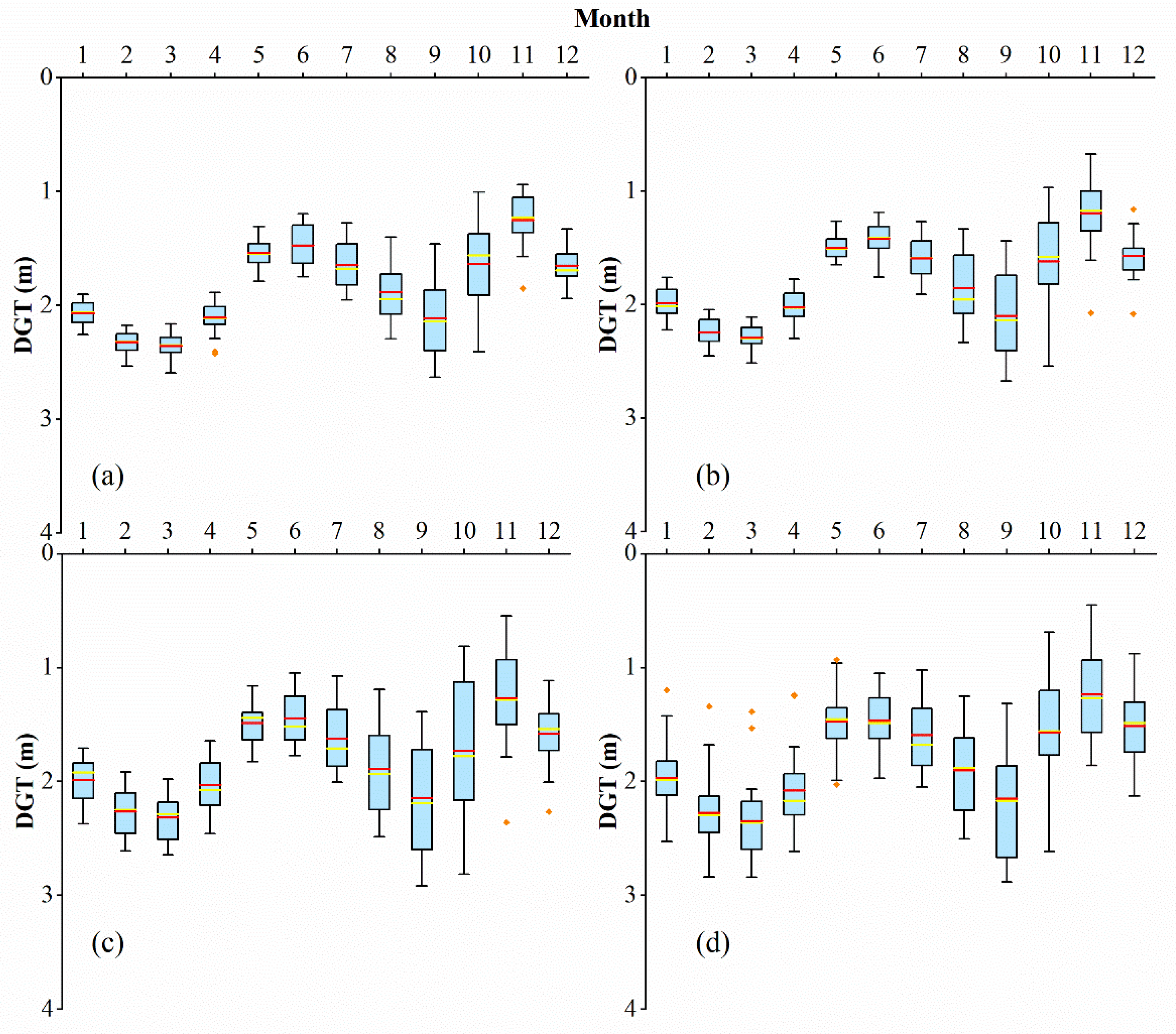
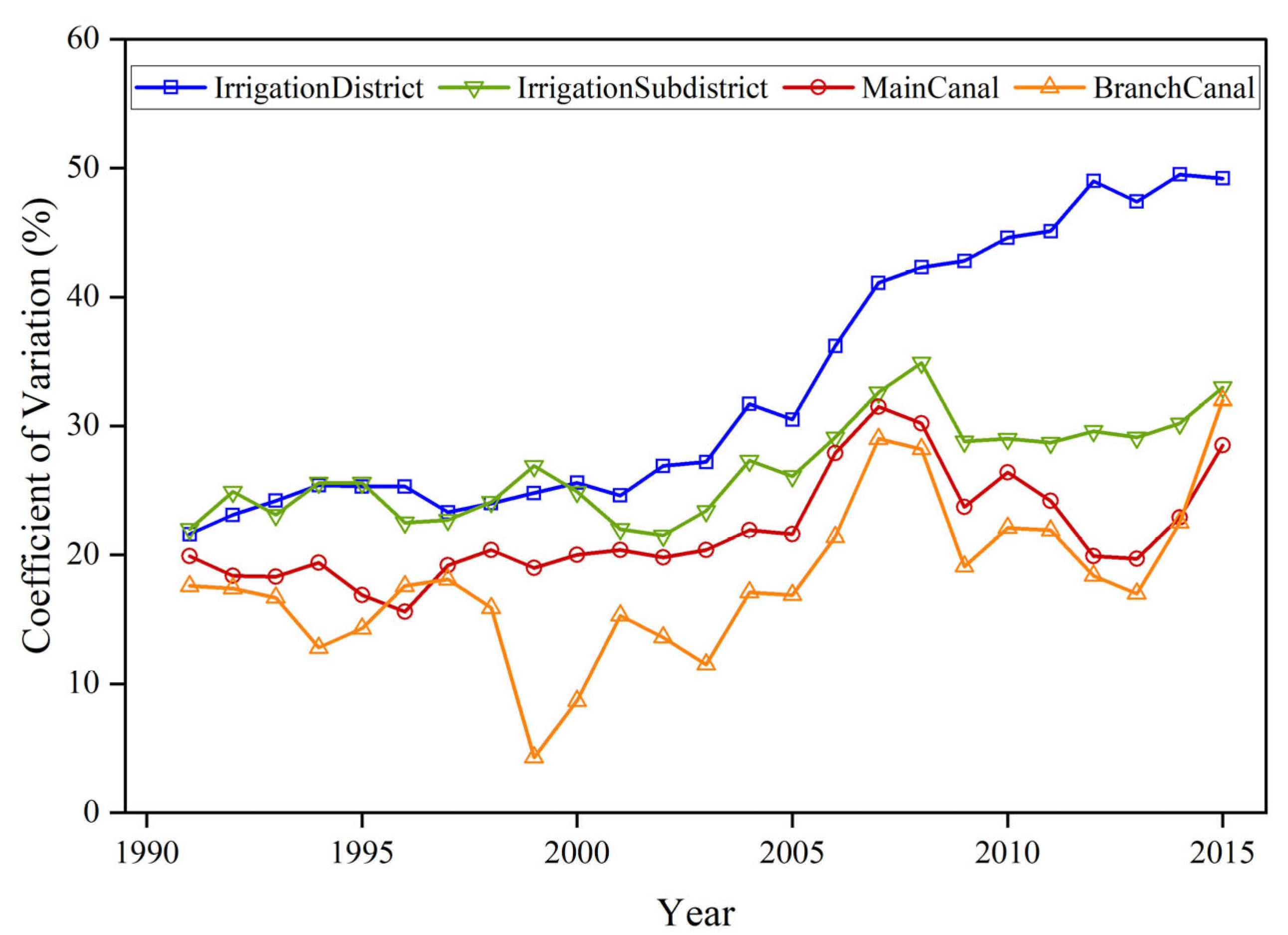

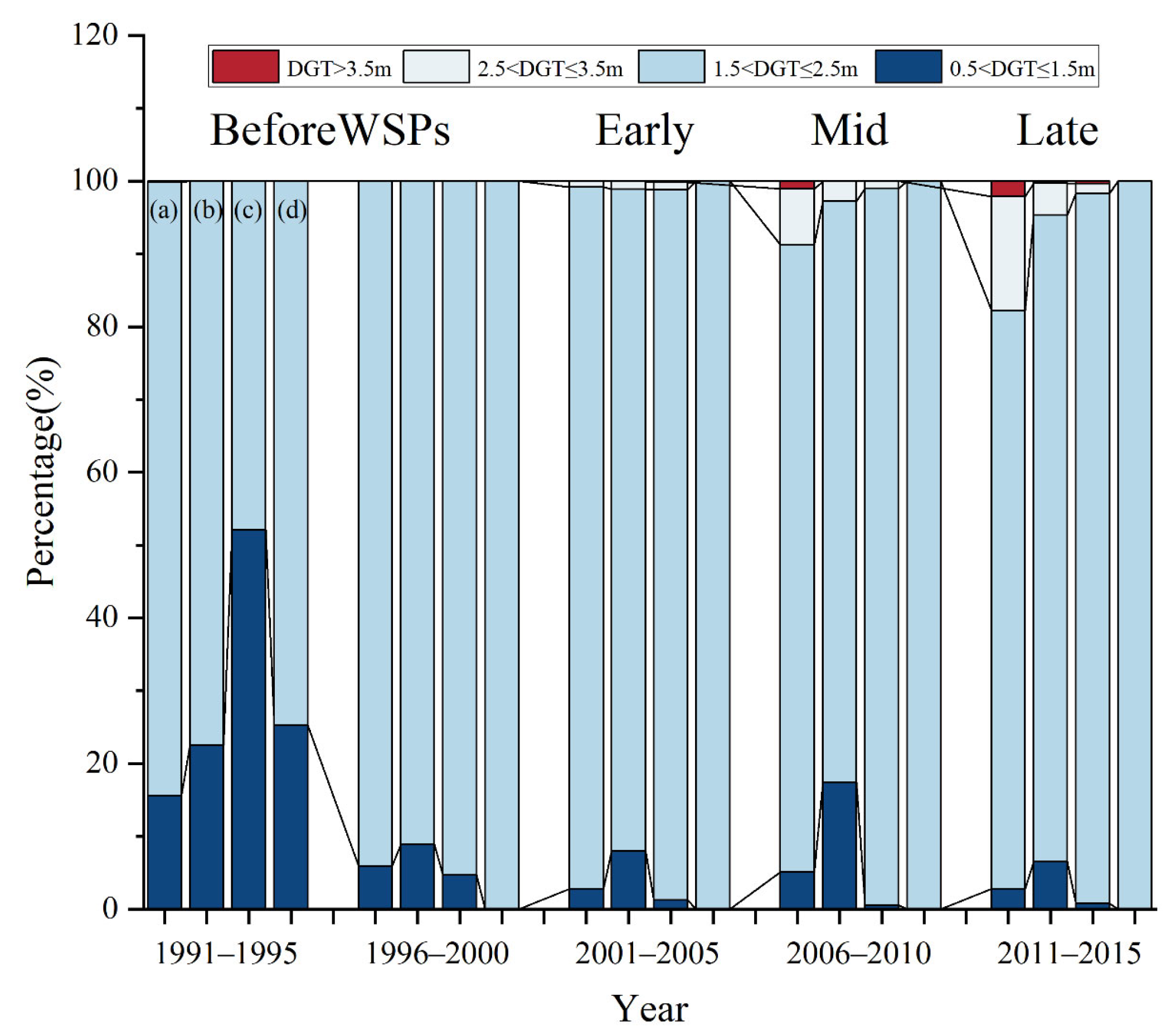
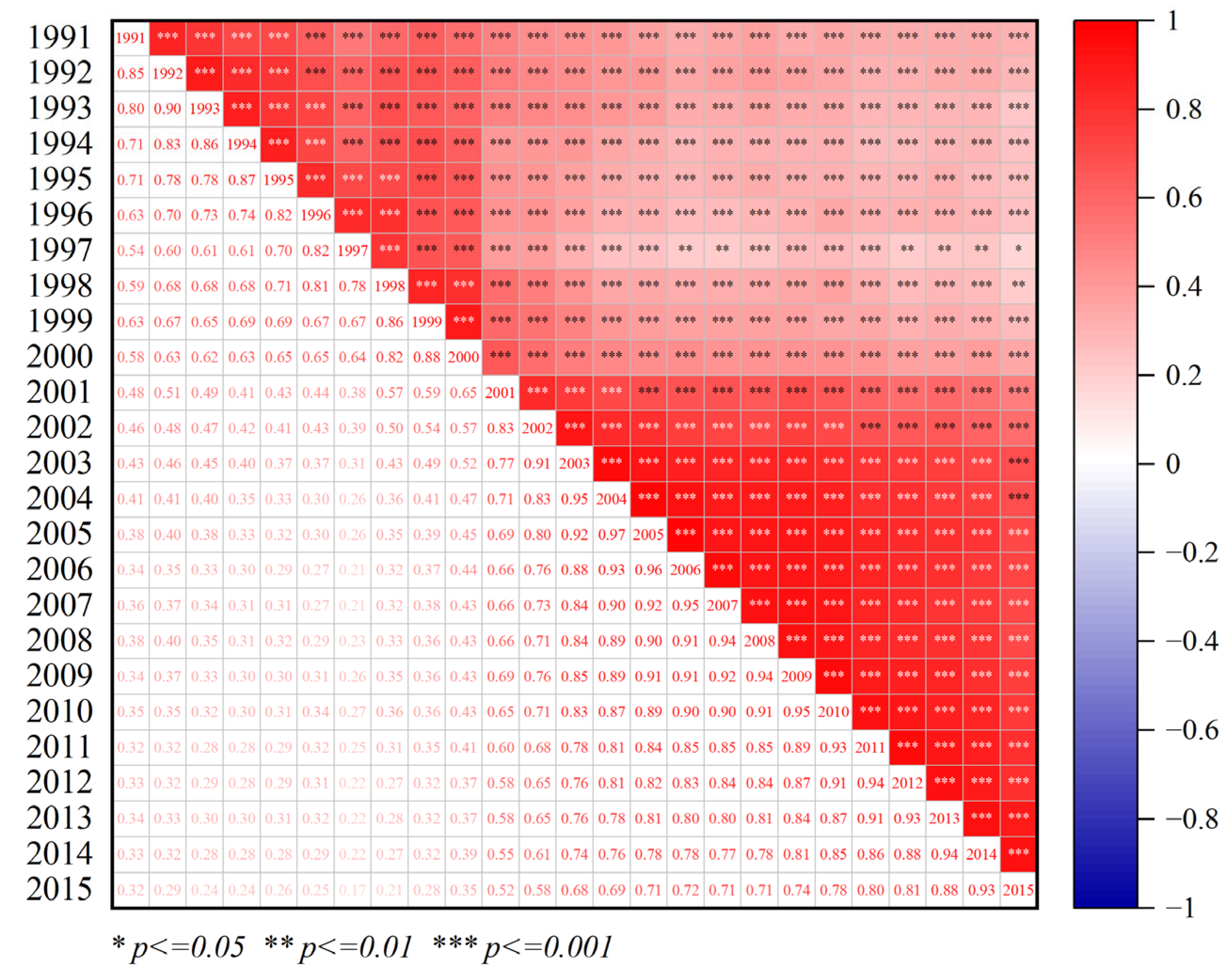
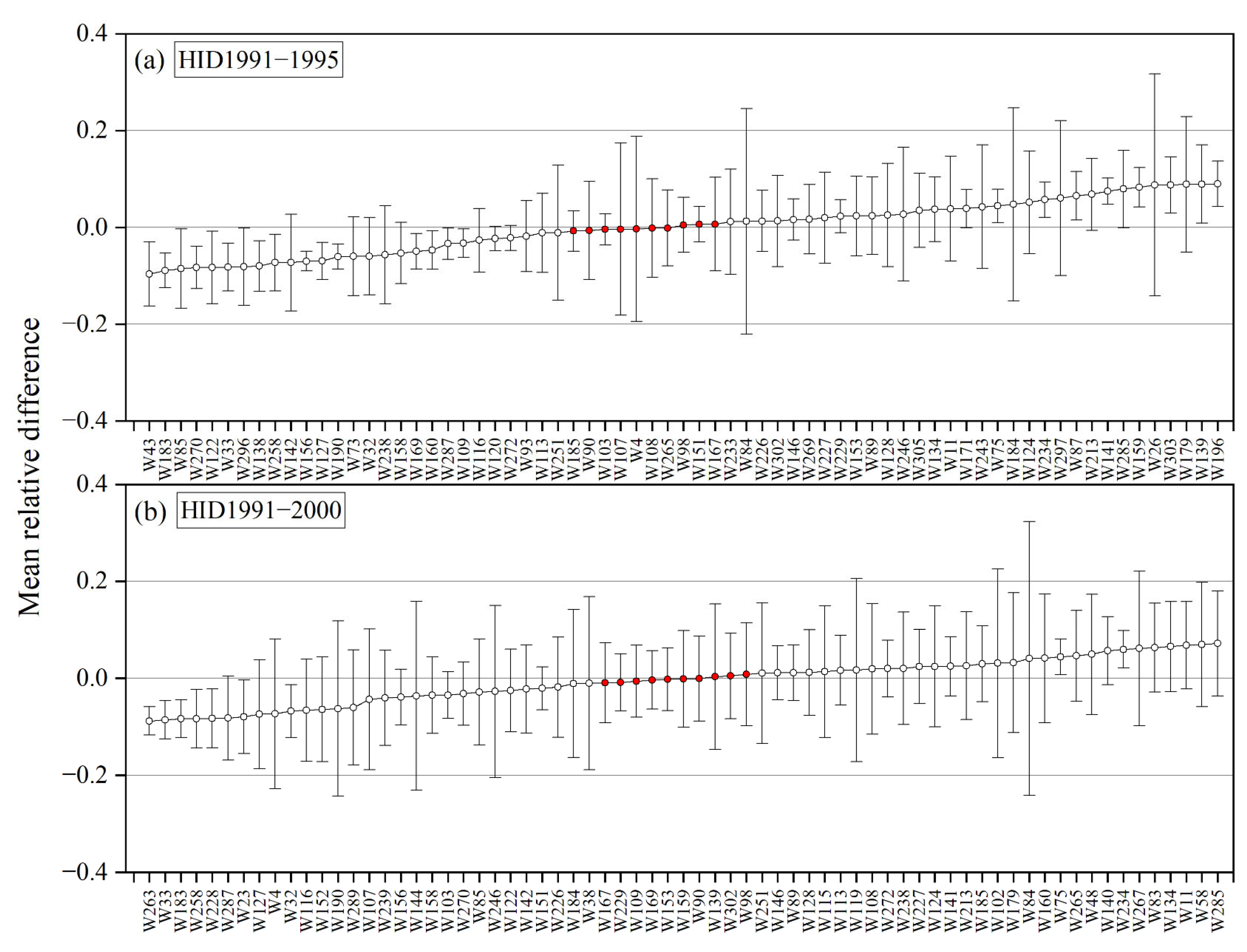
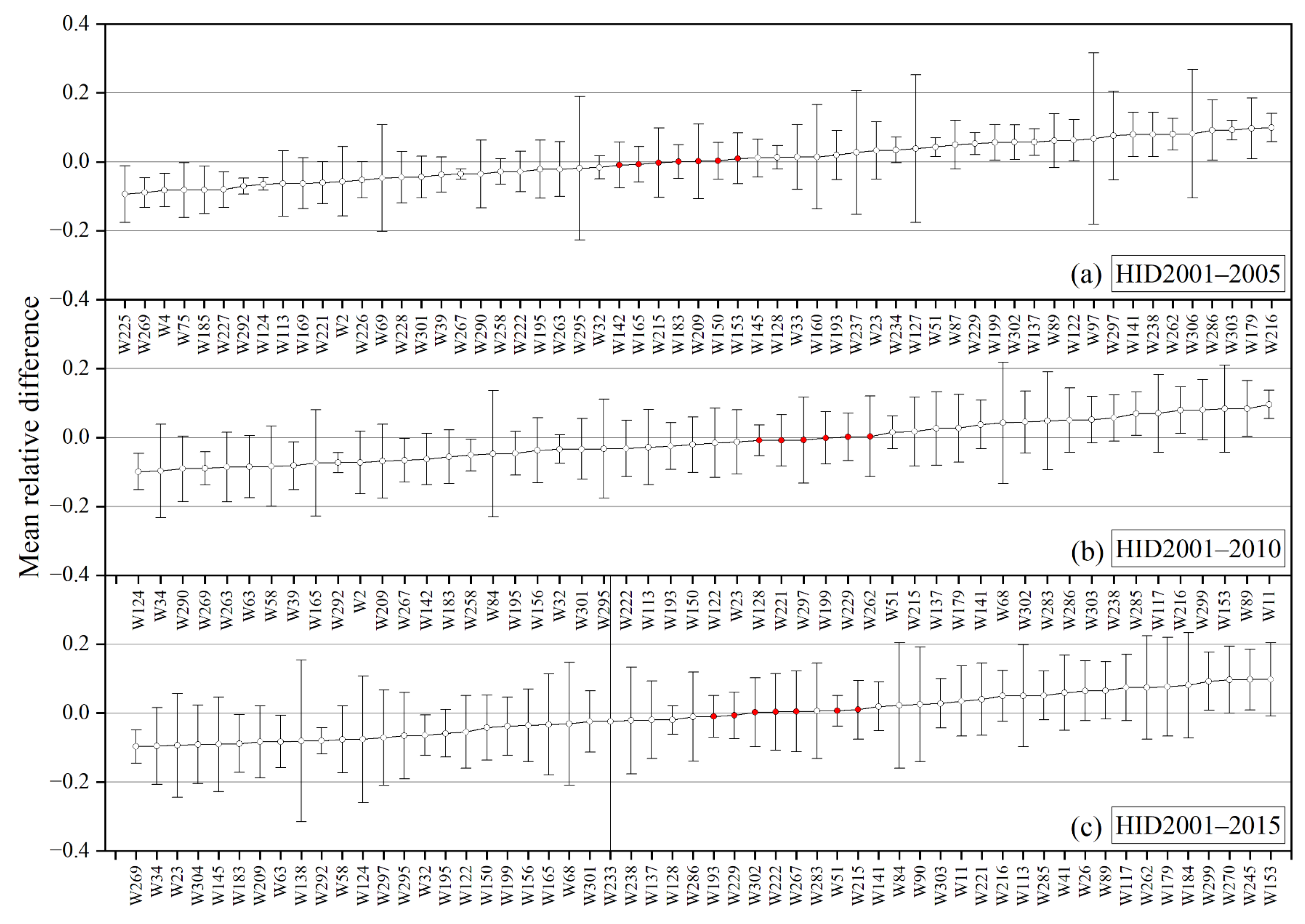
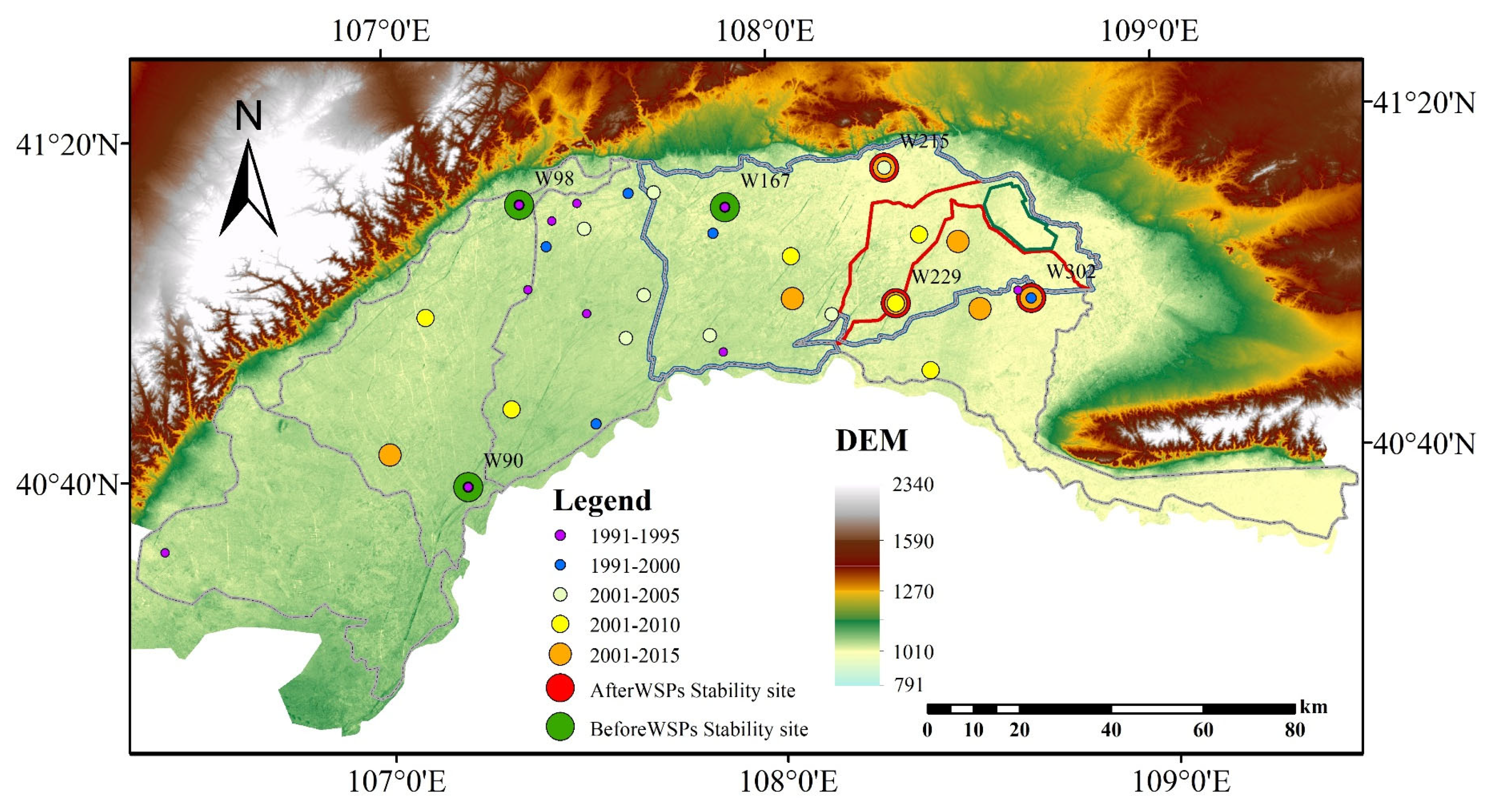
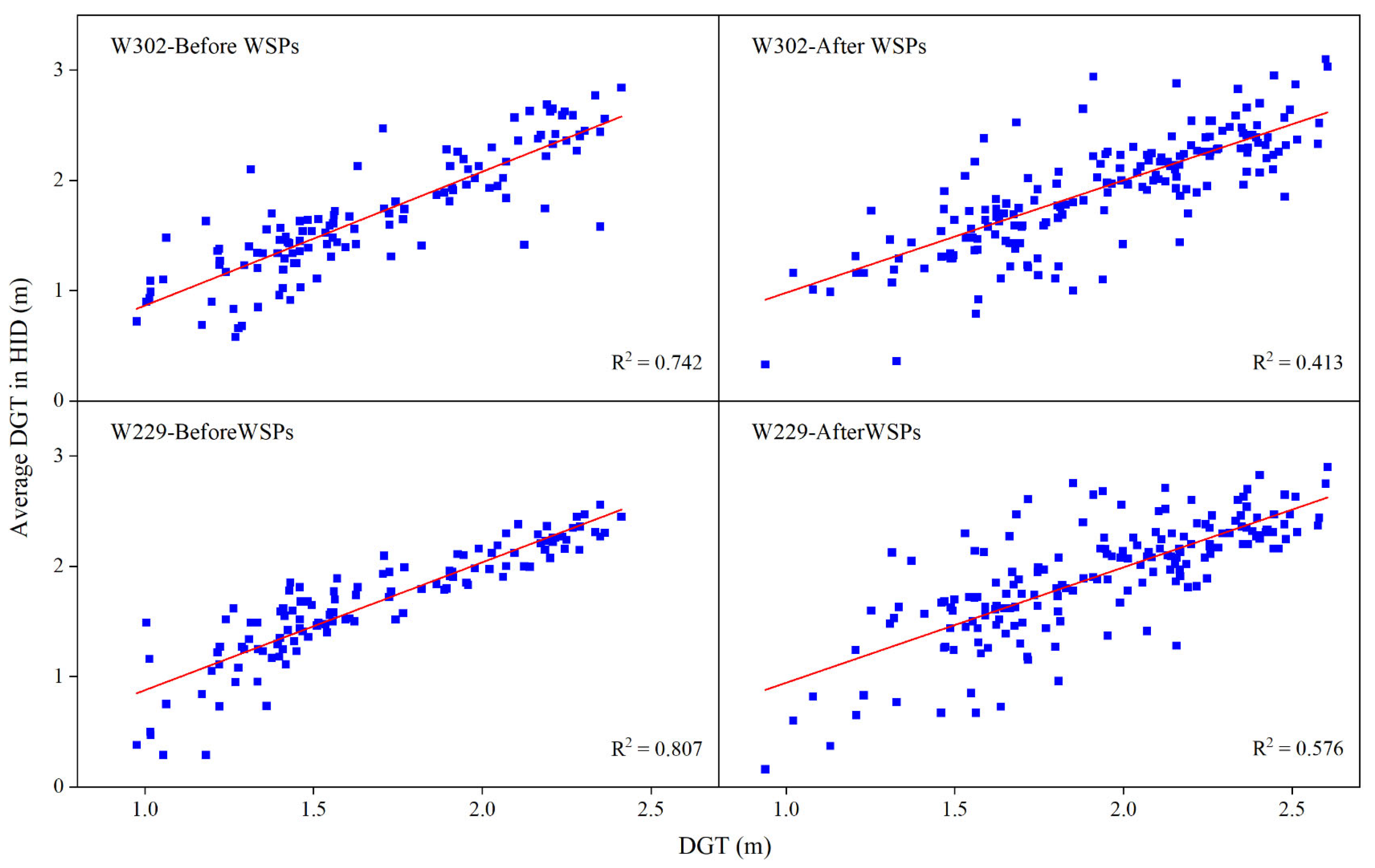
| Irrigation District | Irrigation Subdistrict | Main Canal | Branch Canal | |
|---|---|---|---|---|
| 1991–1995 | 31.49% | 32.19% | 34.29% | 36.27% |
| 1991–2000 | 31.58% | 30.61% | 32.89% | 33.15% |
| 2001–2005 | 28.00% | 27.25% | 28.24% | 30.73% |
| 2001–2010 | 30.06% | 30.23% | 30.76% | 32.45% |
| 2001–2015 | 31.21% | 31.38% | 32.66% | 35.00% |
Disclaimer/Publisher’s Note: The statements, opinions and data contained in all publications are solely those of the individual author(s) and contributor(s) and not of MDPI and/or the editor(s). MDPI and/or the editor(s) disclaim responsibility for any injury to people or property resulting from any ideas, methods, instructions or products referred to in the content. |
© 2023 by the authors. Licensee MDPI, Basel, Switzerland. This article is an open access article distributed under the terms and conditions of the Creative Commons Attribution (CC BY) license (https://creativecommons.org/licenses/by/4.0/).
Share and Cite
Zan, Z.; Yue, W.; Zhao, H.; Cao, C.; Wu, F.; Lin, P.; Wu, J. Analysis of the Scale Effect and Temporal Stability of Groundwater in a Large Irrigation District in Northwest China. Agronomy 2023, 13, 2172. https://doi.org/10.3390/agronomy13082172
Zan Z, Yue W, Zhao H, Cao C, Wu F, Lin P, Wu J. Analysis of the Scale Effect and Temporal Stability of Groundwater in a Large Irrigation District in Northwest China. Agronomy. 2023; 13(8):2172. https://doi.org/10.3390/agronomy13082172
Chicago/Turabian StyleZan, Ziyi, Weifeng Yue, Hangzheng Zhao, Changming Cao, Fengyan Wu, Peirong Lin, and Jin Wu. 2023. "Analysis of the Scale Effect and Temporal Stability of Groundwater in a Large Irrigation District in Northwest China" Agronomy 13, no. 8: 2172. https://doi.org/10.3390/agronomy13082172





